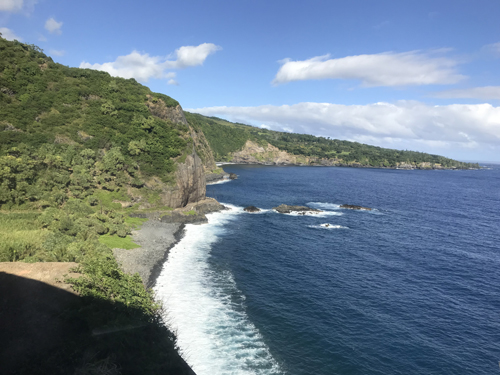We took the long road to Hana and aroond the island (including the part that voids rental car agreements) yesterfay (Thursday), but left the driving to Tai of Roberts Tour Company. It was a long day, as a bus picked us up at just after daybreak a little before 7 a.m. at our resort, then stopped for several others on this side of the island before rendezvousing with 5 folks who flew in from Honolulu for the one-day excursion (and they had an earlier day than we did!). At the airport, we combined into a slightly larger bus driven by Tai, who was born in Maui 62 years ago, spent some time on Oahu and in San Francisco, and has been a tour guide for over 19 years. Next year, he and his sister plan to spend three weeks in Ireland, Scotland, and England. Tai is full of information and good humor, and better he than me as the driver of the Hana Highway, which is much like the first 3/4 mile of the Comptche-Ukiah Road for its better sections, and the section after Hana and before rejoining HWY 37 is like the short ever-failing section of Hwy 1 above Westport--one lane, steep dropoffs mostly without guard rails, and then combined with 600+ switchbacks. A middle section is unpaved. A section of the wider one lane witha stone guard rail is shown below:
 |
| Check out middle of photo--roadside near the offshore rocks: our road. |
Tai was excellent about pulling over to the least possible short pullout, warning us to watch for the few passing cars and not to step on the green areas which could mask a cliff dropoff. One stop was by a grove of rainbow eucalyptus (below) and we all had to stand in the roadway listening for oncoming traffic (none, thankfully) as we snapped our photos.
The eucalyptus, like so many of the Hawaiian Island plants, was introduced. Hawaii might be known widely for its beauty, but it also holds the record for the most extinctions in the world. Due to its
extreme isolation Hawaii once had over 10,000 species found nowhere else on earth. For more than 70 million years, the evolution of new species vastly exceeded losses to extinction. Yet after the arrival of humans to the islands, about 700 years ago, numerous extinctions have occurred with losses including more than HALF of the endemic birds, including flightless ducks, rails, and ibis, hundreds of plant species, and possibly thousands of lesser known terrestrial insects and spiders that were lost
before they were ever described. Recall that these island creatures evolved without the threat of predation by mammals--the introduction of invasive species has led to rapid declines in native birds. Habitat degradation due to plantation plantings (which now tend to lie abandoned here on Maui) caused disappearance of whole forests of native sandalwood trees. Filling the space, and out competing the native vegetation, is often invasive plant species which do not well suit the native critters. But restoration and habitat preservation activities are ongoing, and hopefully, the remaining native species stand a chance of making it long into the future. The Nene, the state bird, for example has made a very good come back.
I wonder how many plants in this picture along the road to Hana are native?
Further down the road from the rainbow eucalyptus were the small communities that dot the Hana highway, including an old church near where Charles Lindbergh spent his last few years. An historic pilot, Lindbergh at age 25 in 1927 made the first nonstop flight from New York, to Paris, France. Later, his baby son was kidnapped and killed in the notorious case described as the "crime of the century." His non-interventionist position in the lead-up to World War II made him a controversial figure, and after he resigned his commission, he was publicly rebuked by President Roosevelt. However. he went on to support the war after Pearl Harbor, flying many combat missions in the Pacific Theatre. Still, he chose to live in relative obscurity in his later life, eventually moving to Hawaii where he died. He is buried in the small cemetery Palapala Ho'omau Church.
After the church, the road worsened, and open range also started. Many cattle were on the road, causing us to frequently stop or slow. The picture of the cow below was taken from by bus window, no zooming....many of her friends were on the road in front of the driver.
We went past the agricultural area of Kala where we had been a few days earlier, and then dropped back into the "town" (the only community large enough to be called a city on Maui) of Kahalui to the airport, and switched over to the bus for our return trip to our condo. The sun set, and it was dark by the time we returned.





No comments:
Post a Comment